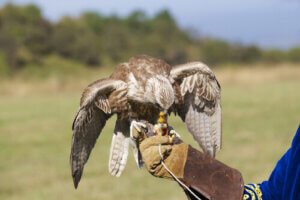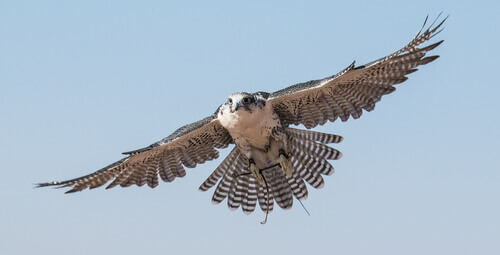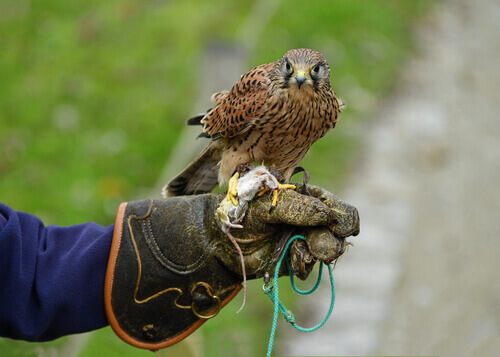How To Train a Falcon


Written and verified by the lawyer Francisco María García
Falconry is an ancient art. The word used to refer to a system of hunting using birds of prey, but nowadays it’s considered a sport. It involves training birds of prey such as hawks, sparrowhawks, goshawks, or eagles which, in theory, are wild. The objective is to train these birds so that they hunt and always return to their owners. Let’s take a look at some of the elements involved in order to better understand this interesting activity, and learn how to train a falcon.
How to choose the bird
It’s important to take the trainer’s level of experience into account when choosing a falcon to train. If the trainer is an apprentice, a Red-tailed Hawk or a female Woolly Hawk are good options.
If the trainer is more experienced, a Harris Hawk might be better. This species is known to be easy to handle, as they’re very intelligent birds and excellent hunters.
How to train a falcon: steps to follow
To train a falcon, the first thing you have to do is to gain the bird’s trust. The falcon has to accept you. Since they’re wild birds, this process can be very slow and difficult. For the first few weeks it’s a good idea to keep it at home, so that you get used to each other’s presence.
Food is the fundamental link between the trainer and the falcon. This is the basis of training and the only stimulus these birds respond to, by instinct. To get started, the falcon has to be able to jump or fly to its owner’s glove, where a piece of food will be waiting.
The trainer should then teach the falcon to fly further away in order to develop its muscles and make it stronger. To do this, put a lure in a kite for the bird to go after. Before it begins to fly, you should probably put a transmitter on its leg so that it doesn’t get lost.
A matter of patience
Falconry, or falcon training, is a sport which requires a lot of time and constant dedication. First, you’ll need to take a course or get help from an experienced teacher. It can also be useful to read all the information you can find on falcons and how to train them.
It’s a good idea to find out about the laws that are in place where you live regarding this practice. You might need a special license to practice falconry.
The training itself demands a lot of patience and perseverance. It’s not the same as training a dog: falcons are wild and fearful animals, so you’ll need to use specific techniques to establish a bond with your bird. You’ll have to dedicate many hours to training and repeating the exercises over and over.
Equipment needed to train a falcon
The activity requires a lot of space; trainers often practice it on the grounds of a country house or something similar. You also have to ensure that health and hygiene conditions are optimal.
In addition, there are a few tools that are indispensable during training in order to guarantee the protection and safety of both the bird and the trainer.
One of the most important pieces of equipment is the falcon hood. This should be made of leather and serves to cover the bird’s eyes and keep it calm. Another fundamental component is the trainer’s glove, which is also leather. This helps make the arm more comfortable for the falcon and, at the same time, to protect the trainer from the bird’s claws.
In addition you’ll need some jesses, which are leather straps that you tie to the falcon’s legs. They’ll help you control the animal while it’s on the glove or on the perch.
How to acquire a falcon
In some countries, the only legal way to acquire a falcon is through a center where they’re held in captivity. If the bird comes from another country, you need a CITES (Convention on International Trade in Endangered Species of Wild Fauna and Flora) certificate. This is an international agreement to protect certain species of animals.
A controversial activity
Falconry is an activity that’s surrounded by much controversy. For some people, it’s a hunting practice that threatens wildlife. For others, it’s an intricate method of communication that creates a very strong bond between man and bird.
Falconry is an ancient art. The word used to refer to a system of hunting using birds of prey, but nowadays it’s considered a sport. It involves training birds of prey such as hawks, sparrowhawks, goshawks, or eagles which, in theory, are wild. The objective is to train these birds so that they hunt and always return to their owners. Let’s take a look at some of the elements involved in order to better understand this interesting activity, and learn how to train a falcon.
How to choose the bird
It’s important to take the trainer’s level of experience into account when choosing a falcon to train. If the trainer is an apprentice, a Red-tailed Hawk or a female Woolly Hawk are good options.
If the trainer is more experienced, a Harris Hawk might be better. This species is known to be easy to handle, as they’re very intelligent birds and excellent hunters.
How to train a falcon: steps to follow
To train a falcon, the first thing you have to do is to gain the bird’s trust. The falcon has to accept you. Since they’re wild birds, this process can be very slow and difficult. For the first few weeks it’s a good idea to keep it at home, so that you get used to each other’s presence.
Food is the fundamental link between the trainer and the falcon. This is the basis of training and the only stimulus these birds respond to, by instinct. To get started, the falcon has to be able to jump or fly to its owner’s glove, where a piece of food will be waiting.
The trainer should then teach the falcon to fly further away in order to develop its muscles and make it stronger. To do this, put a lure in a kite for the bird to go after. Before it begins to fly, you should probably put a transmitter on its leg so that it doesn’t get lost.
A matter of patience
Falconry, or falcon training, is a sport which requires a lot of time and constant dedication. First, you’ll need to take a course or get help from an experienced teacher. It can also be useful to read all the information you can find on falcons and how to train them.
It’s a good idea to find out about the laws that are in place where you live regarding this practice. You might need a special license to practice falconry.
The training itself demands a lot of patience and perseverance. It’s not the same as training a dog: falcons are wild and fearful animals, so you’ll need to use specific techniques to establish a bond with your bird. You’ll have to dedicate many hours to training and repeating the exercises over and over.
Equipment needed to train a falcon
The activity requires a lot of space; trainers often practice it on the grounds of a country house or something similar. You also have to ensure that health and hygiene conditions are optimal.
In addition, there are a few tools that are indispensable during training in order to guarantee the protection and safety of both the bird and the trainer.
One of the most important pieces of equipment is the falcon hood. This should be made of leather and serves to cover the bird’s eyes and keep it calm. Another fundamental component is the trainer’s glove, which is also leather. This helps make the arm more comfortable for the falcon and, at the same time, to protect the trainer from the bird’s claws.
In addition you’ll need some jesses, which are leather straps that you tie to the falcon’s legs. They’ll help you control the animal while it’s on the glove or on the perch.
How to acquire a falcon
In some countries, the only legal way to acquire a falcon is through a center where they’re held in captivity. If the bird comes from another country, you need a CITES (Convention on International Trade in Endangered Species of Wild Fauna and Flora) certificate. This is an international agreement to protect certain species of animals.
A controversial activity
Falconry is an activity that’s surrounded by much controversy. For some people, it’s a hunting practice that threatens wildlife. For others, it’s an intricate method of communication that creates a very strong bond between man and bird.
All cited sources were thoroughly reviewed by our team to ensure their quality, reliability, currency, and validity. The bibliography of this article was considered reliable and of academic or scientific accuracy.
- New York State Department of Environmental Conservation. (2014). New York State Falconry Guide. Recuperado el 18 de agosto de 2022, disponible en: https://www.dec.ny.gov/docs/wildlife_pdf/falcguide.pdf
- California Department of Fish and Wildlife. (2021). Falconry License. Recuperado el 18 de agosto de 2022, disponible en: https://wildlife.ca.gov/Licensing/Falconry
This text is provided for informational purposes only and does not replace consultation with a professional. If in doubt, consult your specialist.








